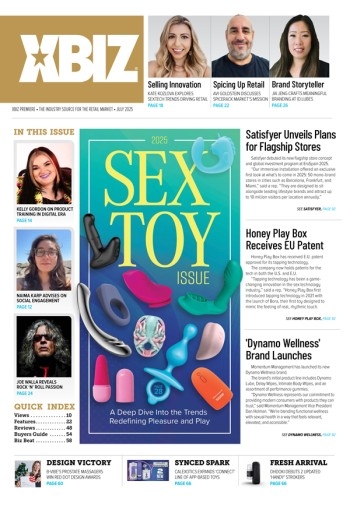What exactly are these ingredients? What do they do? Most importantly, are they safe for the body? These are all questions retailers selling lubes should be able to answer, whether a customer is savvy or not. XBIZ went to the source to get the answers: the people who spend their lives making it.
The Good in Glycerin
There are benefits to using glycerin. It can be found in many common household items including toothpaste, hair care products, deodorant and even food. Jennifer Martsolf, vice president of marketing for Trigg Laboratories, the manufacturers of WET branded lubricants, says glycerin-based lube appeals to those who have a sweet tooth.
“Glycerin is naturally sweet and pleasant tasting,” she said. “It naturally warms on the tongue, which also increases the flavor sensation. Our 4-in-1 Fun Flavors have a glycerin base.”
Martsolf also says that the use of glycerin is not in itself a bad thing; it depends more on the person using it.
“Glycerin and parabens are not necessarily bad for you,” she continued. “Everybody is different. Some people have more sensitive skin than others. Like many things, glycerin is only considered to be toxic in very large doses. Not like those you would get in a topical lotion.”
Desiree Duffie, director of marketing and public relations for Topco Sales, said it is found in high-end cosmetics and moisturizers as well as in personal lubricants.
“Glycerin is a humectant, meaning it attracts moisture,” she explained. “It is beneficial in personal lubricants because it allows the surface of the skin to breathe and inhibits the growth of bacteria.”
Mason Nance, marketing director at Empowered Products, which manufacturers the popular Gun Oil and Pink brands of lubricant, said glycerin is “vegetable-based, water-binding and nonirritating. It is used in personal care products as a softening agent, moisturizer and emollient.”
Travis Curl, director of Vie Products Inc. said glycerin also is used because it’s extremely slippery, water soluble (so it washes off easily), gentle and safe. He also explains the difference between products that contain glycerin and products that contain sugar.
“Some people have heard that glycerin contains sugar,” he said. “Glycerin is a polyol and does not contain sugar, but rather sugar alcohol, which is a completely different compound than sugar. Some warming lubricants add sugar to the ingredients in order to mask the bitter taste of the warming agent (propylene glycol). In larger amounts, this sugar may create a yeast infection in women who are prone to sensitivities (the glycerin is not the cause). When a warming lubricant is desired, use of products that contain sugar substitutes (such as sorbitol or sucralose) is a recommended way to avoid or minimize the chance of a yeast infection.”
Curl mentioned that it is also possible for a very small percentage of customers to be allergic to glycerin; however, this is uncommon since glycerin does not contain any allergens. In every population, there will always be a very small percentage that has a reaction to common everyday items such as milk or nuts. Worth noting is the fact that glycerin has been used for more than 100 years, it is approved by both the FDA and the USP, and it is considered to be safer, more gentle and more stable than any of its substitutes.
Paraben Paranoia?
If you look at a bottle of lubricant you probably wont see the word “paraben” anywhere on it, however that doesn’t mean it doesn’t contain it. Ingredients listed that are parabens will usually end in the letters “ben,” such as methylparaben, propylyparaben, butylparaben, and ethylparaben.
Nance of Empowered Products says two of these common types of parabens have their roots in nature.
“Methylparaben and propylparabens are preservatives derived from benzoic acid, which is naturally found in most berries and other ripe fruit,” he explained. “These two parabens combat the development of bacteria and fungi. Paraben compounds occur naturally in plant sources such as blueberries, prunes, cinnamon, wintergreen and a host of other plants.”
Duffie from Topco also points out that parabens are found in the ingredients of other items beside lubricant.
“Parabens are used in a variety of cosmetics as well as food and drugs,” she said. “They protect the product and the consumer against microbial growth in the product. Basically, they keep people from getting sick and make the shelf-life of the product longer.”
Many lubricant manufacturers stand behind the use of parabens in their products in the right amounts, some have switched to a substitute, and others offer lubricants on both sides of the political debate letting the customer make the decision.
“The methylparaben and propylparaben synthesized in the lab is the same compound found in nature,” Nance said. “They are rapidly metabolized into the byproduct p-hydroxybenzoic acid, which is not stored in tissues, but excreted in urine. Both have no known negative environmental impact and both compounds are very effective at protecting consumers from the adverse consequences of bacterial contamination.”
Knowing What’s in What
A company that made the switch to using neither glycerin nor parabens in its products is Sliquid. Owner Dean Elliot said he went glycerin free in 2002 and stopped using parabens in 2006.
“Instead of using glycerin, we use a plant cellulose, which is derived from cotton fibers,” he explained. “We use cyamopsis, which is a nontoxic, natural additive that enables the plant cellulose to move and act as a slippery substance. We now use phenoxy ephonol (less than half a percent) to kill mold spores and prevent unwanted bacteria during the bottling process.”
Topco Sales, a manufacturer with an FDA registered facility, continues to use parabens in some of its lube formulas, but has options for customers who are against them.
“While Topco Sales doesn’t see any sound scientific evidence to not use parabens or glycerin, we do realize that some customers and consumers are concerned about them,” Duffie said. “That is why we offer choices and make some products without them.”
Topco’s Climax Bursts line of lubricant is glycerin-free and Duffie noted that the company welcomes both retailers and consumers to use its website as a resource when gathering information about ingredients.
“As the home of one of the only FDA registered facilities in the adult industry, we take great measures to ensure the quality and safety of our personal care products,” Duffie continued. “We feel a duty to act as a resource and provide answers to the rest of the industry and the public.”
Other manufacturers offer in-depth information about lubricants on their websites. Retailers are recommended to visit the frequently asked questions [FAQ] sections of each manufacturer’s site to get even more product knowledge to best serve customers.
It seems long gone the days of the customer willing to use just about anything to get the job done. In our economy it is more important than ever to be informed and to inform. A good reputation and earning your customers’ trust can go a long way when it comes to repeat business.







